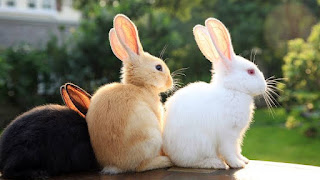GUIDE ON RABBIT REARING
Rabbit rearing is a lucrative business the revenue return on investment is highly commended so it is capable of transforming life within a short time because rabbit is prolific breeder with a short gestation period of about one month. Hence, with the improved breed of one Doe and one Buck, the population can be increased about 10 times within a year.
Rabbit weighs about 3-5kg at maturity. Everything about it has financial value the urine, fesses and meat. Especially the meat is very tasty, tender and low in fat hence highly recommended for a hypertensive patient and those suffering from heart problems.
SYSTEM OF REARING RECOMMENDED
INTENSIVE SYSTEM
BREED recommended:
1. Chinchilla 3. Australian white 5. Crosses
2. Flemish giant 4. California red
HOUSING
One can also convert a poultry house to a rabbit house. Ideally, a house that is good for poultry is also good for rabbits. But it is important to make it a concrete floor for ease of cleaning.
HUTCH SIZE
1) Nursing Doe and its kitten 60cm X 60cm X 48cm
2) Stud Buck 60cm X 60cm X 48cm
3) The above size is the ideal hutch size. It is suitable for 3 fattners. Also, it is convenient for 4 weaners.
4) Mature rabbit is usually kept single in hutches. Raise the hutch about 60cm from the ground. The hutch must be clean.
5) It can be constructed with iron, wire netting and wire mesh or wood. Each hutch must have a base to collect urine and faeces.
6) The entrance of the hutch must be wide enough to allow nesting or kindly in box.
7) All wire hutches is ideal for use inside a building while all wooden or bamboo type can be outside under a tree shade.
FEEDING AND WATERING TROUGHS
1) Small clay pots with concrete around the base are ideal so that they may not be turned over by the rabbits. A metallic container can also be used.
2) Do not use plastic containers they will through away the content
NESTING OR KINDLY BOX
1) This should be made of wood. One should have an opening of at least 25cm in width and 12-15cm from the base. Its dimension is 46cm X 25 cm X 25cm.
2) Old kerosene tin is also adaptable.
3) The bottom of the box should be perforated reasonably to allow urine to drain off.
MATING/MULTIPLICATION
1) One male rabbit (Buck) can comfortably serve 10 females (does) but all must be in separate hutch each. Does and Buck must be 5 or 6 months old respectively before mating.
2) Take the Doe to the Buck every 5 days for mating either in the morning or evening during feeding. Mating should occur immediately or within few minutes. (3-4 minutes)
3) If mating does not occur take away the Doe and then try again another time until the Doe is pregnant. (if pregnant, the Doe will not allow Buck to mate her again).
4) Place nesting box a week before kindling and provide shredded paper (dailies) or cotton wool if Doe fail to shed fur as bedding for its young (kitten). Doe can produce 6 kittens at a time. Pregnancy last 31 days in rabbits.
5) Inspect the nesting box for a deformed or dead kitten after birth and removed them, check periodically to see that young (kitten) are warm.
6) Do not touch kittens with bare hands mostly during the first 4 weeks of life.
7) Wear nylon or glove to cover hands before lifting them from ground or box if needed.
8) Avoid dogs, cats or disturbance during nursing
9) Allow the mother to nurse the kitten for 6-8 weeks before weaning.
MANAGEMENT
It is good to start on a small scale to master the act of rearing or decide to fatten weaners to market weight in order to gain more experience.
STOCKING
1) Transport your animal early in the morning to reduced stress.
2) Buy your animal from a reputable farm where good records are kept.
FEEDING
1) Doe+ kittens 200 concentrate plus 250g green
2) Buck 150g concentrate plus 250g green
Fatteners’ 150g concentrate plus 250g green
Weaner 150g concentrate plus 250g green
WATERING
1) Provide clean, cool and fresh water for drinking.
TIME OF FEEDING:
1) Morning and Evening.
OTHER MANAGEMENT FACTORS
1. Maintain good sanitation on the farm.
2. Avoid an excessive draught within the rabbitry. If too much cold, provide a cover or heat in the building.
3. Quarantine newly bought animals before mixing with an old existing herd.
4. Separate sick one and treat according to the vet officer advice.
5. Keep good records.
Leave your comment or question below and kindly share.




Comments
Post a Comment